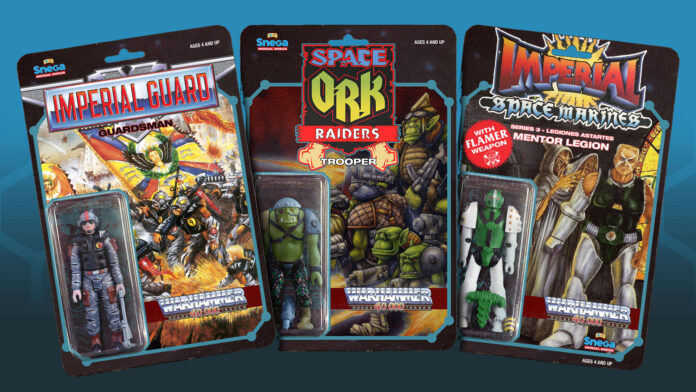Despite the Warhammer 40k brand being built on toy soldiers, it wasn’t until May 2019 (and a partnership with Bandai) that the first official Warhammer 40k action figures appeared. Tammy Nicholls, a former member of Games Workshop’s licensing team, and a Senior Narrative Manager at Riot Games, has been filling in the lost years with incredible hand-crafted recreations of 40k action figures from a 1980s licensing deal that never existed.
Nichols tells Wargamer that she saw her first Warhammer 40k miniatures back when she was “about ten and my father took me to a comic shop”. That started a life-long passion that eventually saw her work in Games Workshop, liaising with other companies creating licensed Warhammer products. But it “was actually a friend who came up with this idea” for fake action figures inspired by the first edition of the game, Rogue Trader.
Nicholls was the one who brought the idea to life, though. Each of the models in these photographs is a physical object, from the figure to the packaging. To make each figure, Nicholls has to “gather as much reference material as I can, sculpt in 3D”, print it on a 3D printer and clean it up. She paints the miniatures “using mostly an airbrush and lacquer paint” rather than regular acrylic paints for miniatures.
To create the packaging, she has “to clean and extend artwork I find on the web” and “re-create logos in Adobe Illustrator”. This “takes a long time but I love it”. There are always challenges translating from Rogue Trader model designs to considerably larger action figures. Nicholls gives the Imperial Guard soldier figure as an example: “Understanding the designer’s intent for how the layers of his flak jacket fitted together based on a mushy 40-year-old plastic sculpt was really tricky but ultimately rewarding”.
The period detail on these products is very impressive, from the limited articulation in the figures to the graphic design styling on the packaging. Nicholls has created an entire alternate history for the figures and the imaginary company that made them, which she calls the ‘trash lore’. You can find trash lore descriptions for each of the figures on her Instagram, building up the history of fake British toy company Nergal Snega and its atrocious owner Bernard Langranges.
The trash lore of the figures lets Nicholls comment on the late 80s era that Rogue Trader was developed within. “I wanted to create a ‘hauntology’ in the vein of wonderful projects like Scarfolk, with some of the cutting sarcasm of Charlie Brooker’s seminal ‘TVGoHome’”, she says.
For Nicholls, the Rogue Trader era is “representative of a very special time in Games Workshop’s history and wider British history”… “a period of unfettered IP creation at the company where they were laying the foundations of what would become a cultural juggernaut”. Certainly, her action figures look like something the experimental GW of the late 80s, with its in-house Warhammer record label, could easily have made if history had only been a little different.
Nicholls adds that “the late 1980s was the last period where certain creative industries were generating new ideas”. She connects this with the concept of ‘Capitalist Realism’ by the late great modern philosopher Mark Fisher. “Creative disciplines have become increasingly obsessed with ‘retro’ and reimagining the past”, Nicholls says, because “the Reaganomics and Thatcherite policies of the 1980s has robbed society of the ability or desire to generate new ideas”, something Fisher calls “the slow cancellation of the future”.
She gives examples of that philosophical idea instantiated in both Warhammer 40k and the company that makes it. “In the real world the 40k brand has become a self-referential IP mainly concerned with re-hashing ideas from the late 1980s”, while the Imperium of Man “is an example of this very same lack-of-newness, too, where its denizens constantly re-hash the past and cannot invent anything”.
If you’re inspired by this incredible pop-culture art project, and want to find more things like it, Nicholls recommends you “start googling things like ‘hauntology’, ‘pop figures’ and ‘folk horror’ and you’ll discover a wealth of blogs and projects”. It’s also worth researching the hashtags that creators you already like are using.
And “if you want to roll your sleeves up and create something” of your own from a past that never existed, Nicholls recommends “finding a medium that you love, be it writing, graphic design, or illustration (or a combination)” and getting to work. To get the vibes right, “go back and research the period looking at things like magazine scans on Archive.org and even read contemporary newspapers”. She promises “you will be both appalled and enthralled!”
This is one of our favorite Warhammer art projects, and a great example of why Warhammer belongs in an art gallery – pop culture has an unparalleled ability to reflect upon culture. For a less cerebral, but no less breathtaking, piece of Warhammer 40k art, check out Baharroth’s Crowning of Guilliman diorama, an incredible translation of 2D art into 3D assemblage.
Source: Wargamer




